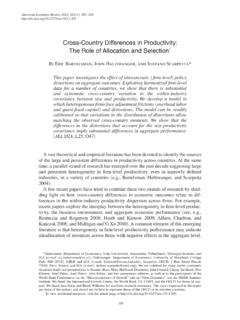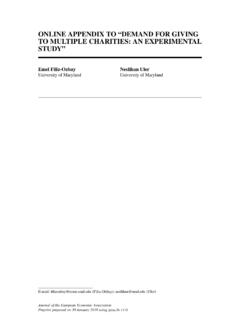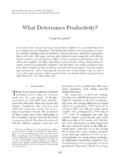Transcription of By Eric Bartelsman, John Haltiwanger and Stefano Scarpetta
1 Not Intended for Publication 1 APPENDIX: CROSS-COUNTRY DIFFERENCES IN PRODUCTIVITY: THE ROLE OF ALLOCATION AND SELECTION By Eric bartelsman , john Haltiwanger and Stefano Scarpetta This appendix presents a detailed sensitivity analysis to assess the robustness of the empirical results and model simulations presented in the main text. The appendix is organized as follows: Section I presents an alternative version of Tables 1 and 2 in the paper in which we present the manufacturing averages of the level and changes of the three key moments STD(LPR), STD(TFPR) and OP using country-average weights instead of US weights to aggregate industry-level indicators. Section II provides a detailed discussion on how we have related the data to model moments. Section III presents model simulations using alternative moments capturing the covariance between size and productivity.
2 In Section IV, we further elaborate on the robustness analysis presented in Section V of the paper. I. Alternative Weights for the Construction of the Key Moments Tables and present the estimated level and changes, respectively, of the three key moments used in our empirical analysis, namely: the within-industry standard deviation of log-revenue labor productivity, STD(LPR); the within-industry standard deviation of log-revenue total factor productivity, STD(TFPR); and the within-industry covariance between size and labor productivity, OP. The indicators presented in these tables represent manufacturing averages obtained by aggregating two-digit industry-level indicators using country averages of industry-weights, instead of the US industry weights as in the original version of the Tables.
3 In other Not Intended for Publication 2 words, the average moments presented in the tables are constructed from industry-level indicators using the average economic structure of the countries in the sample instead of the economic structure of the Comparing these Appendix Tables with the original Tables in the main text reveals that the key moments are very robust to the use of alternative weights for aggregating industry-level indicators to the manufacturing level. Both the average levels and the estimated changes from the first to the second-half of the 1990s are very close to those presented in the original Tables. The United : Averages over 1992-2001 data. Industry-level firm based TFP measures not available for : Firm-level database. See bartelsman , Haltiwanger and Scarpetta (2009).OP covariance termUnited : Change is difference in moments between average value in 1996-2001 and the average value in 1992-1995.
4 Data for Franceonly available from : Firm-level database. See bartelsman , Haltiwanger and Scarpetta (2009).STD in Revenue Labor ProductivitySTD in Revenue Total Factor ProductivitySTD in Revenue Labor ProductivitySTD in Revenue Total Factor Productivity Table : Within Industry Productivity Dispersion and OP Covariance Term(weighted averages of industry-level data, cross-country avg. weights)OP covariance termTable : Changes in Productivity Dispersion and OP Covariance Term(weighted averages of industry-level data, cross-country avg. weights)Not Intended for Publication 3 greatest differences are in the order of log points for the indicators in level and for the first differences, mostly concentrated among the transition economies whose economic structure differs more significantly from that of the US. It should also be stressed that similar results are obtained using country-specific weights to aggregate industry-level moments.
5 II. Measurement Issues in Relating Data to Model Moments In this section, we discuss issues in comparing the calibration to the data moments in Tables 1 and 2. One issue is that we use a value-added production function in the theoretical model and in the calibration. This implies that both in the model and in the calibration, measures of real labor productivity are real value added per worker. Because information on expenditures on intermediate inputs is less comprehensive in the firm-level data for some transition economies, we try to match the cross-country moments of Table 1 that are computed using real gross output per worker instead of value added. While there is a potential for some mismatch, we argue that it does not matter much in practice. The moments from Table 1 are within-industry dispersion and covariance measures and the results in the literature show that real gross output per firm and real value added per firm are very highly correlated within the same industry (Foster, Haltiwanger and Krizan (2001)).
6 For example, the within industry standard deviation of real gross output per worker shown in Table 1 for the ( ) is almost identical to the standard deviation of real value added per worker that we calculated from the underlying data in an identical manner ( ), and this is quite similar to dispersion in value added per worker for the calculated by Syverson (2004a). We also find the within-industry correlation between firm-level real gross output per worker and real value added per worker to be in the Further, for about 3600 of the 5200 country/industry/time observations in the distributed micro analysis database of moments (predominately industrialized countries), we can compute Not Intended for Publication 4 productivity dispersion for both gross output and value added per worker.
7 The correlation between the two measures for this sub-sample is III. Using Alternative Weights in the Covariance As we discuss in the main text, the most robust prediction of models with heterogeneity in TFPQ and curvature in the profit function (from decreasing returns or downward sloping demand curves) is that high TFPQ firms should have high physical output. This prediction holds with minimal restrictions on the structure of demand. At the individual firm level, an increase in TFPQ will lower marginal costs and if the firm faces a downward sloping demand curve the effect will be larger. It will also be likewise generally true that high TFPQ firms will use the most inputs. Distortions in this environment will decrease the correlation/covariance between TFPQ and physical output and TFPQ and inputs.
8 These predictions regarding the correlation between productivity (measured as TFPQ) and size (measured as output or inputs) are illustrated in Figure for the uncorrelated distortion case and Figure for the correlated distortion case. Here for the input weighted case we use a composite input using factor elasticities as weights. It is apparent from these Figures that it does not matter qualitatively whether we focus on the OP covariance measure using output or input weights. Not Intended for Publication 5 As we have also noted in the main text, these predictions about size and productivity carry over to measures of size (as measured by employment) and productivity (as measured by labor productivity, LPR) or alternatively measures of size (as measured by a composite input) and productivity (as measured by revenue total factor productivity, TFPR).
9 Such patterns are apparent in Figures 2 and 3 of the main text. DispersionFigure The Relationship Between the OP Covariance for TFPQ Using Alternative Weights and Distortion Dispersion (Uncorrelated Case)Input WeightOutput DispersionFigure : The Relationship Between the OP Covariance for TFPQ Using Alterantive Weights and Distortion Dispersion (Correlated Case)Input WeightOutput WeightNot Intended for Publication 6 IV. Details on Robustness Exercises In section V of the main text, we report the results of a number of robustness exercises. In this section, we provide more details about these exercises. A. Lower overhead labor One of the key features of our theoretical model is the presence of overhead labor that significantly affects endogenous selection. As discussed in the main text, to assess the implications for our model simulations of a lower overhead labor, we set it very low so that all firms from the ex-ante productivity distribution produce in the absence of distortions.
10 Results presented in the main text suggest that with very low overhead labor we cannot match the moments for labor productivity dispersion or selection. Hence, we benchmark the non-distorted economy to match the standard deviation of TFPR for the Figure 4 in the main text presents the simulated results when we increase the dispersion of distortions (starting from zero). As in Figure 3 in the main text, we focus on the correlated case. Several interesting patterns emerge. First, as discussed in the paper, given the very low overhead labor, there is a substantial range over which increasing distortions has no impact on selection. It is only for large distortion dispersion that selection begins to bite. We intentionally did not set overhead costs to zero since we wanted to show that, if enough dispersion is introduced, this will push some firms to operate at such a small scale that they will not be able to cover their overhead labor costs, however small.







